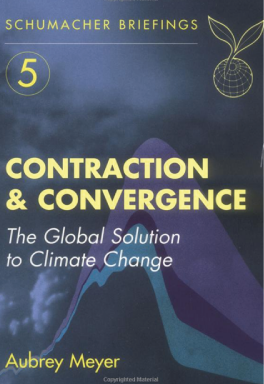The book 'Contraction and Convergence - The Global Solution to Climate Change' summarise a ten year campaign at the UFCCC [1990 - 2000] to establish 'C&C' as the organising principle for UNFCCC-compliance.
Since then it has been very frequently cited as the source reference quoted for C&C [described as GCI 2000]. In fact it is one of the most frequently sources cited in all the climate change policy literature.

However, in spite of [or perhaps even because of] this success, this source has also been routinely cited and systematically misquoted by Ecofys and other often European authors, who assert or imply that GCI projected a fixed C&C agenda with '2050' almost invariably cited as the convergence-date.
This is wholly and it would appear, because it is persistent and systematic, wilfully inaccurate.
Here are direct quotes from the book itself on the subject of the rates of C&C. It is perfectly clear that this GCI C&C source book says nothing at all about: -
- "convergence being by 2050" or
- "convergence being gradual transition over decades" as asserted by Ecofys and that
- Ecofys et al asserting the above as a 'GCI position' is a complete invention by these authors.
What this book actually says on this matter of the rates of convergence is: -
- As the graphs show, any date of convergence on equal per capita emissions can be portrayed in the C&C model.
- I was therefore able to adjust it to show the US reaching convergence by 2100 in one scenario and the Chinese by 2010 in another.
- I showed both countries this and told them that negotiating the date (and hence the rate) of convergence was their problem not mine.
- A faster rate of convergence simply means that high population, low-per-capita emissions countries like China get a larger share of emissions permits sooner and vice versa the US."
The book makes it perfectly clear that - subject to the maths of observing the limit insccribed in the UNFCCC-objective - negotiating these rates are the task of the UFCCC-negotiators.
The book also provided two graphic examples ofcalculated output from the C&C model re rates of contraction and convergence: -
- convergence by 2010
- convergence by 2030
Some Support for the Classic C&C Concept over the years.
BACK TO ECOFYS DELIBERATELY MISQUOTES & MISREPRESENTS C&C